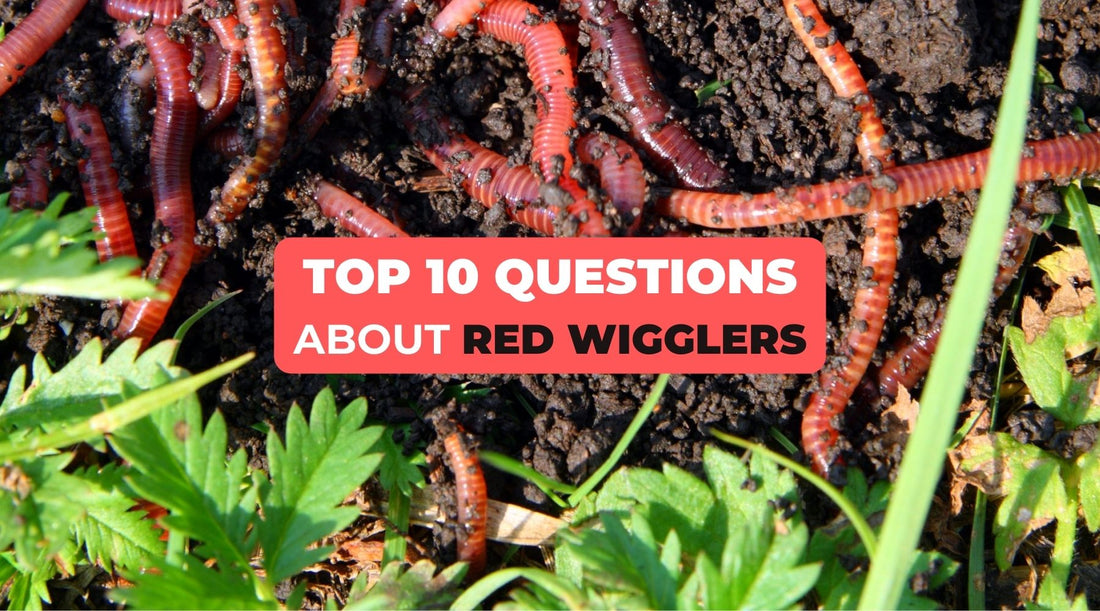Unveiling the Top 10 Mysteries of Red Wigglers
Welcome, worm enthusiasts, to an exploration of the captivating realm of red wigglers! These humble yet industrious composting companions hold the key to unlocking the secrets of vermicomposting. Today we embark on a journey to unravel the top 10 questions surrounding red wigglers, shedding light on these fascinating creatures and their role in sustainable waste management!
1. What Sets Red Wigglers Apart from Other Worms?
Red Wigglers, scientifically known as Eisenia fetida, are prized for their efficient composting capabilities. Distinguished by their voracious appetite and rapid reproduction, these worms thrive in organic waste environments, setting them apart as vermicomposter's worm of choice.
- Composting Prowess: Unlike some earthworm species that primarily dwell in soil, red wigglers thrive in organic waste environments. This specialized adaptation makes them highly effective at breaking down kitchen scraps and transforming them into nutrient-rich compost.
- Voracious Appetite: Red wigglers can devour food scraps equivalent to half their body weight each day, making them efficient waste processors. This insatiable hunger contributes to the rapid breakdown of organic materials in a vermicomposting system.
- Rapid Reproduction: Red wigglers are prolific reproducers, adding to their appeal for vermicomposting enthusiasts. A single red wiggler can produce multiple cocoons each week, and within a few months, these cocoons hatch into baby worms.
- Adaptability: Red wigglers exhibit a remarkable ability to adapt to various environmental conditions. This adaptability makes red wigglers a versatile choice for vermicomposting across diverse climates and settings.
-
Preferential Habitat: Unlike some earthworms that burrow deep into the soil, red wigglers prefer to reside in the upper organic layer. This behavior makes them well-suited for life in worm bins, compost piles, and other confined spaces where organic waste is abundant.
2. How Can I Provide the Best Care for Red Wigglers at Home?
Creating an optimal environment for red wigglers requires a thoughtful approach. Consider the following essential elements to care for red wigglers at home and ensure their well-being:
- Use a bedding of shredded newspaper or cardboard.
- Maintain consistent moisture levels and temperatures within the range of 32°F to 90°F.
3. Can Red Wigglers Be Utilized in Outdoor Compost Bins?
The versatility of red wigglers extends to outdoor composting systems. To successfully incorporate them, consider these precautions for less controlled environments:
- Provide a protective layer of leaves or straw.
- Monitor and adjust for extreme temperatures and potential predators.
Check out our in-depth compost guide here.
4. Do Red Wiggler Worms Sleep?
Worms don't have eyelids or a conventional sleep cycle, but they do have periods of reduced activity. Red wiggler worms are most active during the night and early morning, while they tend to rest during the day. Their activity levels are influenced by environmental factors, such as light and temperature.
5. What Do Red Wiggler Worms Eat?
Red wiggler worms have a discerning palate that favors organic kitchen waste. Ensure a balanced diet by feeding them:
- Fruit and vegetable scraps
- Coffee grounds and tea leaves
- Crushed eggshells
- Avoid acidic or oily foods to maintain the delicate balance of the worm bin
Checkout our in depth guide for an optimal red wiggler diet here.
6. How Can I Keep My Worm Bin Odor-Free?
Maintaining an odor-free worm bin involves implementing specific practices:
- Avoid overfeeding to prevent anaerobic conditions.
- Mix the bedding regularly to aerate the bin.
- Add a handful of dry, shredded newspaper if the bin becomes too wet.
7. Do Red Wiggler Worms Lay Eggs?
Indeed, they do! Red wiggler worms reproduce by laying tiny, lemon-shaped eggs in protective cocoons. These cocoons are usually deposited in the bedding and hatch into baby worms within a few weeks. The rapid reproduction cycle of red wigglers is one of the reasons they are favored for vermicomposting.
8. Where Are Red Wiggler Worms Native To?
Originally native to Europe, red wiggler worms have become widespread globally due to human activity. Their adaptability and resilience have made them a popular choice for vermicomposting in various regions around the world.
9. Can Red Wigglers Survive Extreme Temperatures?
Yes! They can survive from a range of 32°F to 90°F. They are super adaptable critters. Consider protective measures for very extreme temperatures such as:
- Insulating the worm bin with layers of straw or leaves.
- Moving the bin to a sheltered area during very extreme weather conditions.
- Burying the bin underground.
- Taking your bin inside to your garage, shed, basement, or house.
10. Are Red Wiggler Worms Good for the Garden?
Absolutely! Red wiggler worms provide a plethora of benefits for the garden. Their nutrient-rich castings act as an excellent natural fertilizer, enhancing soil fertility and promoting plant growth. The improvement in soil structure and the suppression of harmful pathogens make red wigglers valuable allies in creating a healthy and thriving garden ecosystem.
Conclusion
As we conclude our journey into the intriguing world of red wigglers, armed with answers to the top 10 questions, may your vermicomposting adventures be fruitful and your gardens flourish with the help of these remarkable composting companions. Happy composting!


2 comments
Starting vermicomposting in 17 gal bins. I’d like to start with 50 worms. What size order should be placed?
On a new till garden, how many pounds to square feet?